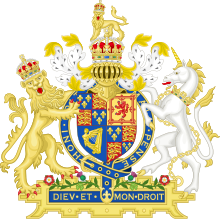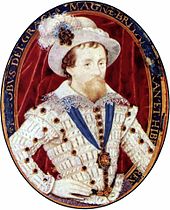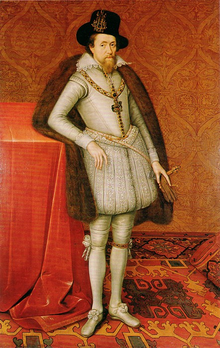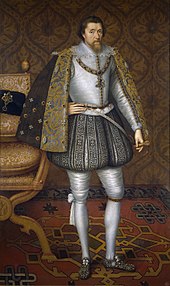James I (England)
Jakob (* 19th June 1566 in Edinburgh , Scotland ; † 27. March 1625 in Theobalds Park, County Hertfordshire , England ), English James was from 1567 when James VI. King of Scotland and from 1603 until his death additionally as James I, King of England and King of Ireland .
Life
King of Scotland
He was born on June 19, 1566 in Edinburgh to Mary Queen of Scots and her second husband Henry Stewart , Duke of Albany, better known as Lord Darnley. He was baptized Catholic in Stirling Castle and given the name Charles James. On the occasion of his baptism, the first fireworks displayed in writing took place in Scotland.
When Mary Queen of Scots was imprisoned in Loch Leven Castle a year later and had to abdicate, James was born as an infant under the name of Jacob VI. appointed King of Scotland. He spent his childhood in Stirling Castle. Several successive rulers exercised power during his minority, first his first guardian, James Stewart, 1st Earl of Moray , a half-brother of his mother. After the assassination of the regent Moray by a follower of Mary on January 23, 1570, war broke out in Scotland between the party of the king (James VI.) And the party of the queen (Mary Stuart). Official regent was his grandfather Matthew Stewart, 4th Earl of Lennox , Darnley's father, who was also murdered by Maria's partisans a year later, and finally John Erskine, 18th Earl of Mar , who died in 1572. Under him, the Puritan George Buchanan became his tutor, and Jacob was brought up to be a Protestant. The strict upbringing, which was characterized by frequent flogging , spoiled his religious puritanism.
It was not until after 1572 that there was a phase of stability under James Douglas, 4th Earl of Morton . With the help of an English force, he defeated the last supporters of Maria Stuart at Edinburgh Castle. As regent, Morton secured the pro-English and Protestant rule desired by Elizabeth I. Morton had to resign as regent in 1578. The twelve year old Jacob VI. was formally declared king. In 1579 Esmé Stuart , Sieur d'Aubigny, came from France , Earl of Lennox since 1580, who, with the support of Captain James Stewart, from 1580 to 1585 Earl of Arran, gained control of the king and kingdom. Lennox had renounced the Catholic faith for the sake of the king, but was suspected by the Scottish lords of continuing to hold on to it. It was also believed that he might have a pernicious influence on the king's homoerotic tendencies. He was detained at Ruthven Castle and eventually forced to return to France after ten months in prison.
In 1582 a group of nobles conspired to prevent a possible return of Mary Queen of Scots to Scotland. Their conspiracy resulted in the Ruthven Raid , a - ultimately failed - coup led by William Ruthven, 1st Earl of Gowrie , on August 22, 1582. The king was kidnapped during a hunt in Angus not far from Ruthven Castle and lasted for almost a year imprisoned there and in other castles of the insurgents.
In 1584 Parliament confirmed the supremacy of the Crown over the Church, forcing radical ministers and the Ruthven Lords into exile in England. Under the Chancellor John Maitland, 1st Lord Maitland of Thirlestane (1537–1595), royal power was further consolidated. In 1586 Jakob concluded an alliance with England against Spain in the Treaty of Berwick , to which he adhered after his mother was executed in 1587 on behalf of Queen Elizabeth I of England , although he formally protested against the execution.
On August 20, 1589, his marriage to Anna of Denmark , daughter of King Frederick II of Denmark , was concluded by proxy . The personal wedding was rescheduled on November 23, 1589 in Oslo, which was then Danish . In 1590 Anna was crowned queen. The 1590s were marked by clashes between Catholics and Protestants in Scotland . Although Anna and Jakob were quite close at the beginning of their marriage, their relationship deteriorated as the marriage progressed. Above all, the handing over of Anna's firstborn to the care of Lord and Lady Carr led to alienation. Although she grew up as a Protestant , she converted to Catholicism shortly after her marriage . This led to a loss of reputation and put Jacob in an uncomfortable position when he became King of England in 1603.
King of England, Ireland and Scotland


When Queen Elisabeth died childless in 1603, Jacob, the great-great-grandson of King Henry VII of England (from the line of his eldest daughter Margaret ), was also crowned King of England and Ireland. This began the rule of the Stuarts in these countries. From now on, James ruled Scotland from a distance “with a pen ” and did not return to his home country until 1617. From the beginning, Jakob tried to consolidate the fragile personal union between the two realms. He proclaimed the term Great Britain , which had been used primarily geographically until then, as a political term for his kingdoms of England and Scotland. He introduced the Union Jack , the overlay of the English Cross of St. George and the Scottish St. Andrew's Cross , as a flag and began to speak of southern and northern Great Britain instead of England and Scotland. However, he was unable to achieve his goal of soon merging the two states into a single entity - neither in the English nor in the Scottish parliament was there a majority for this.
Jacob's rule in England was shaped by the political contradictions to parliament; a violent escalation of the conflict could still be avoided. In 1605 the gunpowder plot ("Gunpowder Plot") was uncovered at the last minute, with which radical English Catholics wanted to carry out an attack on the king and parliament. In 1606, Jacob divided North America into two halves: the area of the London Company should extend from 34 degrees north to 41 degrees, and the area of the Plymouth Company from 41 degrees to 45 degrees . In 1607 the London Company (also known as the Virginia Company of London ) founded Jamestown , the first permanent English settlement in North America. On behalf of Jacob, a translation of the Bible into English was made, which first appeared in 1611 and was to have a profound influence on the English Church , of which he was the head, and on English literature . As the King James Bible , it is still one of the best-known English-language Bible editions to this day.
King Jacob's relationship with the English Parliament was extremely tense. The system of government at the time made it impossible for him to obtain sufficient income without the approval of parliament. This was contrary to his ideas of god-given kingship . For this reason, he often refused to respond to criticism or petitions from Parliament at all, and appeared rather undiplomatic towards parliamentary representatives. He made the sale of titles a source of income: from 1611 he awarded the knighthood against payment of 1,000 pounds, for which the acquirers were allowed to call themselves baronets , and peer degrees including their seats in the House of Lords were sold en masse to wealthy citizens. In early 1622 the differences escalated and on February 8th of that year he dissolved Parliament after his plans for a marriage between his son Charles and the Catholic Princess Maria Anna of Spain were not approved.
It is speculated that Jacob had homosexual tendencies; in any case, he maintained very close personal friendships with various courtiers. The most influential among them was George Villiers, 1st Duke of Buckingham , who was able to maintain his position under Jacob's successor, Charles I. Jakob wrote a book about poetry and gathered a circle of poets at his court ( Castalian Band , to which, among others, Alexander Montgomerie belonged). Jakob was considered a proponent of the witch hunt , which he defended in his treatise on demonology , published in 1597 , in which he contradicted the criticism of the Englishman Reginald Scot , among other things . According to traditions, which are now in doubt, he is said to have had his witch-skeptical work Discovery of Witchcraft (1584) burned after he took office in 1603. In 1604, Jakob issued a new, stricter witchcraft law that was not repealed until 1736. However, he also warned of the dangers of persecution based on unsubstantiated allegations. There were no more massive witch hunts during his reign in England; in the last decade of his reign five people were executed for witchcraft.
He disapproved of the election of his son-in-law, Elector Friedrich V of the Palatinate , as the Bohemian “Winter King” (1619/20) as an unnecessary provocation of the Habsburg emperor, but supported Friedrich with money after his expulsion from Bohemia; In particular, he financed the troops of Count von Mansfeld to recapture the Palatinate, which had been occupied by Spanish-Habsburg troops, but in vain. For this purpose he also sent his son and heir to the throne Charles to Madrid to offer an alliance and marriage between Charles and a Spanish king's daughter. The Spaniards, who were closely allied with Vienna, reacted cautiously and demanded a conversion of Charles to Catholicism, which made marriage impossible.
Jacob died on March 27, 1625. His eldest son Heinrich, Prince of Wales , had died in 1612, so that his younger son Charles succeeded Charles I in all three countries. He then married a French princess and entered into an alliance with France, the arch enemy of the Habsburgs.
While Jacob's achievements as King of England are judged inconsistently, he is regarded as an extraordinarily successful Scottish king who decisively reshaped the state and society. The talented, calculating and spirited Jacob was also called "the wisest fool of Christendom".
Marriage and offspring
Jacob I married Princess Anna of Denmark on August 20, 1589 . With her he had the children
- Henry Frederick (1594-1612)
- Child, stillborn 1595
- Elizabeth (1596–1662), wife of Elector Friedrich V of the Palatinate , the "Winter King"
- Margaret (born December 29, 1598), died at the age of 1600
- Charles (1600–1649), German Karl I, was King of England from 1625 to 1649
- Robert Bruce (born January 18, 1602), Duke of Kintyre , died in 1602
- Son, died shortly after birth in 1603
- Mary (born April 18, 1605), died at the age of two
- Sophie (born June 22, 1606), died the next day
See also
literature
- Ronald G. Asch : Jakob I. (1566-1625). King of England and Scotland; Ruler of Peace in the Age of Wars of Religion. Kohlhammer, Stuttgart 2005, ISBN 3-17-018680-9 .
Web links
- Publications by and about Jakob I. in VD 17 .
- Literature by and about Jakob I. in the catalog of the German National Library
- Works by and about Jakob I in the German Digital Library
- Historical Collections of Private Passages of State: Volume 1 - 1618-29 , British History Online
Individual evidence
- ↑ Redecorating the Royal Birthing Room. James VI's birthplace at Edinburgh Castle to get makeover. In: Historic Scotland. The Magazine for Historic Scotland Members. Fall 2013, p. 5.
- ↑ Thomas Christopher Smout: A history of the Scottish people, 1560-1830. Collins / Fontana, London 3rd ed. 1975, p. 95.
- ↑ Helmut Weber: Oppressed Nation or Beneficiary of the Union? Scotland's role in the UK ( Memento of the original of March 8, 2012 in the Internet Archive ) Info: The archive link has been automatically inserted and has not yet been checked. Please check the original and archive link according to the instructions and then remove this notice. (PDF; 136 kB), there pp. 2–5
- ↑ According to Werner Sombart , Liebe, Luxus und Kapitalismus (1922), between 1611 and the end of the reign of his grandson, Jakob II., In 1688, 200 new peers were awarded. Quoted from Jens Jessen : What remained of the nobility. A bourgeois consideration , on Klampen Essay 2018, ISBN 978-3-86674-580-3
- ↑ Illustration from 1627: Abilltung as royal maistat in Engelandt Die Artickel Dess Spanish Heyraths Iur. Confirmed Anno 1623 ( digitized version )
- ↑ Philip C. Almond: King James I and the Burning of Reginald Scot's The Discoverie of Witchcraft: The Invention of a Tradition. In: Notes and Queries 56 (2009), Issue 2, pp. 209–213 doi : 10.1093 / notesj / gjp002 .
- ↑ Ferdinand Zahlner: Personenlexikon to Paranormologie. Online publication ( Memento of the original dated December 2, 2017 in the Internet Archive ) Info: The archive link was inserted automatically and has not yet been checked. Please check the original and archive link according to the instructions and then remove this notice. (Keyword Jakob (James) I. ), Resch-Verlag , Innsbruck 2011.
| Predecessors | Office | successor |
|---|---|---|
| Maria I. |
King of Scotland 1567–1625 |
Charles I. |
| Elizabeth I. |
King of England King of Ireland 1603–1625 |
Charles I. |
| personal data | |
|---|---|
| SURNAME | Jacob I. |
| ALTERNATIVE NAMES | Jacob VI (from 1567, King of the Scots) |
| BRIEF DESCRIPTION | King of Scotland, England and Ireland |
| DATE OF BIRTH | June 19, 1566 |
| PLACE OF BIRTH | Edinburgh |
| DATE OF DEATH | March 27, 1625 |
| Place of death | Theobalds ( Herefordshire ) |







